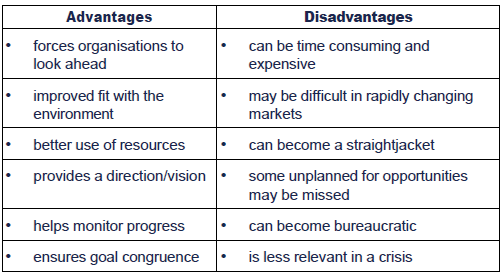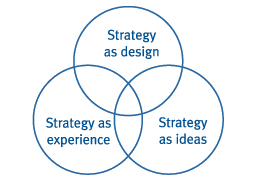Business Strategy
This page introduces some of the main terms used in discussions about strategy. It also looks at the meanings of the word 'strategy' and asks to what extent strategic planning is useful. It then goes on to outline the main steps in formulating strategy
Definitions
Strategic planning
'Strategic planning' can also be known as 'long-term planning' or 'corporate planning'. Those alternative names give some insight into the nature of strategic planning. It:
- considers the longer term (think of a time-horizon of about five years or beyond)
- considers the whole organisation.
Other characteristics of strategic planning are that:
- it gives direction to the whole organisation, and integrates its activities
- it considers all stakeholders
- it looks at how to gain a sustainable competitive advantage
- it relates the organisation, its resources and competences to its environment.
Strategy
There is no universally accepted definition of strategy, and the word is used in different contexts to mean different things. The following definition is as useful as any.
'Strategy is a pattern of activities that seeks to achieve the objectives of the organisation and adapt its scope, resources and operations to environmental changes in the long term.'
Why bother with strategic planning?
Studies show that companies that plan are more successful than those that do not.
Strategic planning can have the following potential advantages:

Strategic planning is particularly important when:
- there are long lead times
- the business needs to be turned around
- there is high capital expenditure
- many stakeholders are affected.
The rational 'top down' approach to strategic planning
The traditional approach
This approach breaks down the process of strategic planning into three distinct steps:
This can be represented in the diagram below. Broadly, information about the organisation and its environment is collected and rational decisions are made about future courses of action .
A modern adaptation
The Johnson, Scholes and Whittington (JSW) model of strategic planning is a modern development of the rational planning model.
It consists of the three elements already discussed (analysis, choice,implementation) but instead of presenting these linearly, it recognises interdependencies.
For example, it might only be at the strategy into action (implementation) stage that an organisation discovers something that sheds light on its strategic position, resulting in a new strategy being formulated.
The other key difference is that Johnson, Scholes and Whittington argue that strategic planning can begin at any point.
For example, firms might decide that they will launch an internet sales division without first carrying out any strategic analysis or choosing how the new strategy might compete.

The strategic position/analysis
Assessing the strategic position consists of analysing:
- the environment (competitors, markets, regulations, discoveries etc). Key factors are often summarised as opportunities and threats.
- the strategic capability of the organisation (resources, competences). Key factors are often summarised as strengths and weaknesses)
- the culture, beliefs and assumptions of the organisation
- the expectation and power of stakeholders (what do the shareholders want? Will employees co-operate?).
Strategic choice
Strategic choice follows strategic analysis and is based upon the following three elements.
- Generation of strategic options, e.g. growth, acquisition, diversification or concentration.
- Evaluation of the options to assess their relative merits and feasibility.
- Selection of the strategy or option that the organisation will pursue. There could be more than one strategy chosen but there is a chance of an inherent danger or disadvantage to any choice made. Although there are techniques for evaluating specific options, the selection is often subjective and likely to be influenced by the values of managers and other groups with an interest in the organisation.
In addition to deciding the scope and direction of an organisation,choices also need to be made about how to achieve the goal.
Broadly,there are two ways in which a strategy can be pursued:
- internal development (organic growth)
- external development - merger/acquisition, JV, franchising/licensing.
Your FeedbackWe value your feedback on the topics or anything else you have found on our site, so we can make it even better.Give Feedback Strategy into action (implementation)
Implementing a strategy has three elements.
- Organising/structuring. For example, should the organisation be split into European, US and Asian divisions? How autonomous should divisions be? What parenting style would be appropriate?
- Enabling an organisation's resources should support the chosen strategy. For example, appropriate human resources and assets need to be acquired.
- Managing change. Most strategic planning and implementation will involve change, so managing change, in particular employees' fears and resistance, is crucial.
Alternative approaches to strategy development
Emergent strategies
The research of Mintzberg (1987) suggests that few of the strategies followed by organisations in the real world are as consciously planned as the approaches above suggest.
He believes this to be an unrealistic view of strategic planning, believing instead that strategies evolve over time (emerge) rather than result from an in-depth analysis of every aspect of the environment and an impartial evaluation of every possible alternative.
Emergent strategies do not arise out of conscious strategic planning, but result from a number of ad hoc choices, perhaps made lower down the hierarchy. In this view, the final objective of the strategy is unclear and elements still develop as the strategy proceeds, continuously adapting to human needs - the emergent strategy is evolving, incremental and continuous.
Emergent strategies develop from patterns of behaviour; one idea leads to another, until a new pattern is formed and a new strategy has emerged. For example, a salesman visits a customer out in the field. The product isn't right, and together they work out some modifications. The salesman returns to the company and puts the changes through; after two or three more rounds, they finally get it right. A new product emerges, which eventually opens up a new market. The company has changed strategic course.
Incrementalism
Lindblom did not believe in the rational model to decision making as he suggested that in the real world it was not used, citing the following reasons.
- Strategic Managers do not evaluate all the possible options open to them but choose between relatively few alternatives.
- It does not normally involve an autonomous strategic planning team that impartially shifts alternative options before choosing the best solution.
- Strategy making tends to involve small-scale extensions of past policy - 'incrementals' - rather than radical shifts following a comprehensive search.
Lindblom believed that strategy making involving small scale extensions of past practices would be more successful as it was likely to be more acceptable as consultation, compromise and accommodation were built into the process. He believed that comprehensive rational planning was impossible and likely to result in disaster if actively pursued.
Freewheeling opportunism
Freewheeling opportunists do not like planning. They prefer to see and grab opportunities as they arise.
- Intellectually, this is justified by saying that planning takes too much time and is too constraining. Probably, the approach is adopted more for psychological reasons: some people simply do not like planning.
- Often such people are entrepreneurs who enjoy taking risks and the excitement of setting up new ventures. However, once the ventures are up and running, the owners lose interest in the day-to-day repetitive administration needed to run a business.
Levels of strategic planning
Corporate Strategy
What business is the firm in? What businesses should it be in?
These activities need to be matched to the firm's environment, its resource capabilities and the values and expectations of stakeholders.
How integrated should these businesses be?
Business Strategy
Looks at how each strategic business unit (SBU) attempts to achieve its mission within its chosen area of activity.
Which products should be developed?
What approach should be taken to gain a competitive advantage?
Which markets to enter?
Functional or Operational Strategy
Looks at how the different functions of the business support the corporate and business strategies.
Note that it is not always clear and rarely important whether a decision is classified as corporate, business or functional.
Consistency
The strategies at the different levels should be consistent.There's no point having a corporate strategy that says that the organisation should move up-market, if the business strategy is to stay in cheap markets and operations provide low-quality products and services.
Strategic choices need to be made at every level, though obviously choices made at any particular level can influence choices at other levels.
The strategy lenses
Overall, strategy is likely to come from a variety of sources and a combination of the above techniques. Johnson and Scholes talk about 'strategic lenses', which are three ways of viewing what can be meant by the term 'strategy'. These are as follows.
Strategy as design.
This is the view that strategy formulation is a rational, logical process where information is carefully considered and predictions made. Strategic choices are made and implementation takes place. Essentially this is the same as the rational planning model discussed earlier.
Strategy as experience.
This is the view that future strategies are based on experiences gained from past strategies. There is strong influence from the received wisdom and culture within an organisation about how things should be done. This reflects the emergent approach described above.
Strategy as ideas.
This is the view that innovation and new ideas are frequently not thought up by senior managers at the corporate planning level. Rather, new ideas will often be created throughout a diverse organisation as people try to carry out their everyday jobs and to cope with changing circumstances.

Johnson and Scholes suggest that viewing strategy through only one of these lenses can mean that problems that the other lenses might show up are missed. For example, too much reliance on incremental changes (strategy as experience) might overlook radical new developments that could be essential for the organisation's success (strategy as ideas).
It is worth considering the very strong influence the design and experience lenses have in large organisations and government departments. Often, the larger the organisation, the less able it is to adopt early essential but radical changes.
Ideally, managers should try to look at strategy through all three lenses in turn.
|
Created at 10/11/2012 2:24 PM by System Account
(GMT) Greenwich Mean Time : Dublin, Edinburgh, Lisbon, London
|
Last modified at 11/1/2016 3:52 PM by System Account
(GMT) Greenwich Mean Time : Dublin, Edinburgh, Lisbon, London
|
|
|
|
 |
Rating
:
|
 Ratings & Comments
(Click the stars to rate the page) Ratings & Comments
(Click the stars to rate the page)
|
 |
Tags:
|
|
|
|
|